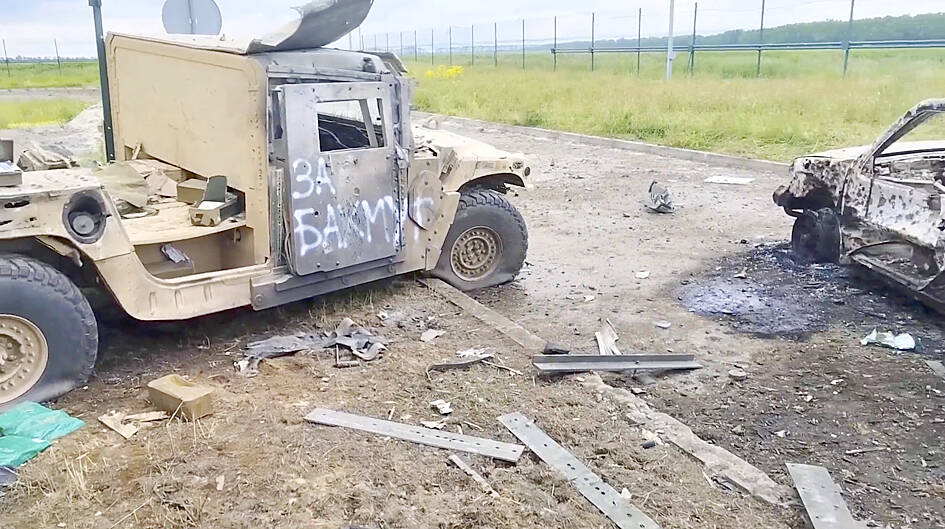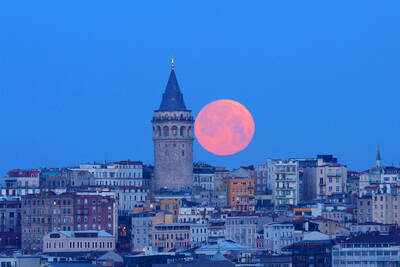Russia’s military on Tuesday said that it had quashed what appeared to be one of the most serious cross-border attacks from Ukraine since the war began, claiming to have killed more than 70 attackers in a battle that lasted about 24 hours.
Moscow blamed the raid that began on Monday on Ukrainian military saboteurs. Kyiv portrayed it as an uprising against the Kremlin by Russian partisans.
It was impossible to reconcile the two versions, to say with certainty who was behind the attack or to ascertain its aims.

Photo: EPA-EFE / RUSSIAN MINISTRY OF DEFENSE PRESS SERVICE
The battle took place in southwest Russia’s Belgorod region, about 80km north of Kharkiv in eastern Ukraine.
The region is a Russian military hub holding fuel and ammunition depots, and it was included in Russian President Vladimir Putin’s order last year to increase the state of readiness for attacks and improve defenses.
Kremlin spokesman Dmitry Peskov refused to say how many attackers were involved in the assault or comment on why efforts to put down the attackers took so long.
The Belgorod region, like the neighboring Bryansk region and other border areas, has witnessed sporadic spillover from the war, which Russia started by invading Ukraine in February last year.
Far from the 1,500km front line in southern and eastern Ukraine, Russian border towns and villages regularly come under shelling and drone attacks, but this week’s attack is the second in the past few months that also appears to have involved an incursion by ground forces.
Another difference from earlier cross-border attacks is that Russia’s effort to repel it continued into a second day for the first time.
Russian Ministry of Defense spokesman Igor Konashenkov said that local troops, airstrikes and artillery routed the attackers.
“The remnants of the nationalists were driven back to the territory of Ukraine, where they continued to be hit by fire until they were completely eliminated,” Konashenkov said.
He did not mention any Russian casualties.
Russian forces destroyed four armored combat vehicles and five pickup trucks the attackers used, he said.
Local officials said that the invaders also used drones and artillery.
Belgorod Governor Vyacheslav Gladkov said that the raid targeted the rural area around Graivoron, a town that is about 5km from the border.
Twelve civilians were wounded in the attack and a woman died during an evacuation, he said.
The Russian news portal RBK, quoting unidentified sources in the Belgorod Ministry of the Interior and territorial police, said Graivoron came under heavy shelling that lasted about five hours early on Monday.
After that, tanks fired at the Graivoron border checkpoint while the adjacent village of Kozinka came under mortar and rocket fire, RBK reported.
Gladkov later reported that a Koznika villager had been killed.
The attacking force was made up of 10 armored vehicles and an unspecified number of troops, RBK said.
Earlier on Tuesday, the regional governor urged residents who had evacuated not to return home until they received official instructions to do so.
He said a “counterterrorism operation” was completed by early Tuesday evening.
Gladkov said in a video that federal authorities’ claims for the past year that “everything is under control” do not ring true in light of this attack and prior assaults.
He appealed again to the Kremlin to strengthen defenses.

DEBT BREAK: Friedrich Merz has vowed to do ‘whatever it takes’ to free up more money for defense and infrastructure at a time of growing geopolitical uncertainty Germany’s likely next leader Friedrich Merz was set yesterday to defend his unprecedented plans to massively ramp up defense and infrastructure spending in the Bundestag as lawmakers begin debating the proposals. Merz unveiled the plans last week, vowing his center-right Christian Democratic Union (CDU)/Christian Social Union (CSU) bloc and the center-left Social Democratic Party (SPD) — in talks to form a coalition after last month’s elections — would quickly push them through before the end of the current legislature. Fraying Europe-US ties under US President Donald Trump have fueled calls for Germany, long dependent on the US security umbrella, to quickly

RARE EVENT: While some cultures have a negative view of eclipses, others see them as a chance to show how people can work together, a scientist said Stargazers across a swathe of the world marveled at a dramatic red “Blood Moon” during a rare total lunar eclipse in the early hours of yesterday morning. The celestial spectacle was visible in the Americas and Pacific and Atlantic oceans, as well as in the westernmost parts of Europe and Africa. The phenomenon happens when the sun, Earth and moon line up, causing our planet to cast a giant shadow across its satellite. But as the Earth’s shadow crept across the moon, it did not entirely blot out its white glow — instead the moon glowed a reddish color. This is because the

Romania’s electoral commission on Saturday excluded a second far-right hopeful, Diana Sosoaca, from May’s presidential election, amid rising tension in the run-up to the May rerun of the poll. Earlier this month, Romania’s Central Electoral Bureau barred Calin Georgescu, an independent who was polling at about 40 percent ahead of the rerun election. Georgescu, a fierce EU and NATO critic, shot to prominence in November last year when he unexpectedly topped a first round of presidential voting. However, Romania’s constitutional court annulled the election after claims of Russian interference and a “massive” social media promotion in his favor. On Saturday, an electoral commission statement

Chinese authorities increased pressure on CK Hutchison Holdings Ltd over its plan to sell its Panama ports stake by sharing a second newspaper commentary attacking the deal. The Hong Kong and Macau Affairs Office on Saturday reposted a commentary originally published in Ta Kung Pao, saying the planned sale of the ports by the Hong Kong company had triggered deep concerns among Chinese people and questioned whether the deal was harming China and aiding evil. “Why were so many important ports transferred to ill-intentioned US forces so easily? What kind of political calculations are hidden in the so-called commercial behavior on the